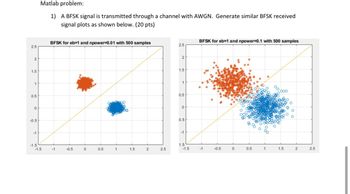
Introductory Circuit Analysis (13th Edition)
13th Edition
ISBN: 9780133923605
Author: Robert L. Boylestad
Publisher: PEARSON
expand_more
expand_more
format_list_bulleted
Question

Transcribed Image Text:Matlab problem:
1) A BFSK signal is transmitted through a channel with AWGN. Generate similar BFSK received
signal plots as shown below. (20 pts)
BFSK for eb=1 and npower=0.01 with 500 samples
BFSK for eb=1 and npower=0.1 with 500 samples
2.5
2.5
2
1.5
1
0.5
0
-0.5
-1
2
1.5
1
0.5
0.5
-1
-1.5
1.5
-1.5
-1
-0.5
0
0.5
1.5
2
2.5
-1.5
-0.5
0
0.5
1
1.5
2
2.5
Expert Solution
This question has been solved!
Explore an expertly crafted, step-by-step solution for a thorough understanding of key concepts.
Step by stepSolved in 2 steps with 5 images

Knowledge Booster
Similar questions
- A baseband signal has the spectrum sketched in the first image added below. The baseband signal modulates a 98 kHz carrier sine wave. Using frequency and amplitude labelling similar to that in Figure 2, sketch the spectrum of the modulated signal using a template added in image 2, for the following modulations: i-AM with the amplitude of the carrier wave being 20 V ii-DSBSC iii-SSB – the lower sideband iv-SSB – the upper sidebandarrow_forwardWhat is Maximum Usable Frequency (MUF)? Derive the expression of MUF critical frequency (fcr) and skip distance assuming curve earth.arrow_forwardQ2: A modulating signal is used to modulate a carrier signal(AM modulation). Let Pr . Pc. PSB. PuSB. PLSB and u are the total power, carrier power, side band power, upper side band power, lower side band power and modulation index respectively. Prove the following: a. Pc = Pr () c. Pusn = Pisn =) Pr m2 b. Psn = Pr %3D 2+m2 LSB 2+m? (2+m2arrow_forward
- Starting from the general expression of the frequency modulated wave, find out the expression of narrow band FM (NBFM).arrow_forward7-22arrow_forwardQuestion 2 (a) Briefly explain the advantage of the following Amplitude Modulation (AM) type and state ONE (1) application for each AM type: i. Double Sideband Full Carrier (DSBFC) ii. Double Sideband Suppressed Carrier (DSBSC) iii. Single Sideband (SSB). (b) The AM waveform for the modulated signal is illustrated in Figure 1. i. Calculate the percentage of modulation index, m. ii. State the type of the modulated signal. Justify the answer. iii. Write the equation for the modulated signal. iv. Calculate the percentage of power efficiency. 3V -1IV Figure 1arrow_forward
- a.) The average signal power is Ps What is the minimum distance d for each signal constellation 1-4? b.) Let the noise power PN be a constant. Sort the constellations 1-4 on signal-to-noise ratio Ps and express the differences in signal-to-noise ratios in decibels. PN c.) Assume that the real and imaginary parts nī and no of the noise are independent. In d d d d P (n₁ ²2 ) = P ( nq > =/ ) = > =p 2 addition let P\n< where the minimum distance d is the same for all constellations 1-4. What is the symbol error probability for each constellation as a function of p where all symbols are equally probable? 1. 3. d d Im Re Re 2. 4. d d d d d 0 d 9 d Im d Re Rearrow_forward[Q2] Illustrate the signal waveforms of PAM, PWM, and PPM in simple drawings. [Q3] Suppose (t) has the spectrum in the figure below, where f = 550kHz and € = 460kHz. Sketch Xs(f) for f. = 1.6MHz if ideal sampling is considered. X(f) AÏN -f f₁ + E 0 fuarrow_forwardA 10 MHz TXCO is driving a receiver’s front end and has a frequency deviation of 4 ppm. It drives a direct down conversion RF front-end mixing the L2 frequency. What is the frequency offset at baseband due to the TXCO?arrow_forward
- Q2: A modulating signal is used to modulate a carrier signal(AM modulation). Let Pr , Pc, Psa. PusB, PLSB and u are the total power, carrier power, side band power, upper side band power, lower side band power and modulation index respectively. Prove the following: a. Pc = Pr () c. Pusp = Pasa =) P, 2+m2. b. PsB = Pr %3D 2+m2 2 (2+m2arrow_forward78. To assure the same accuracy at both 100 Hz and 100 MHz, the signal level into a frequency counter must be A higher at 100 MHz B. higher at 100 Hz C. inductively coupled at 100 MHz and capacitively coupled at 100 Hz D. resistively coupled at 100 MHz and direct coupled at 100 Hzarrow_forwardPlease, I do not want a theoretical solution or using artificial intelligence. I want a solution on paper using the mathematical laws of the topicarrow_forward
arrow_back_ios
SEE MORE QUESTIONS
arrow_forward_ios
Recommended textbooks for you
 Introductory Circuit Analysis (13th Edition)Electrical EngineeringISBN:9780133923605Author:Robert L. BoylestadPublisher:PEARSON
Introductory Circuit Analysis (13th Edition)Electrical EngineeringISBN:9780133923605Author:Robert L. BoylestadPublisher:PEARSON Delmar's Standard Textbook Of ElectricityElectrical EngineeringISBN:9781337900348Author:Stephen L. HermanPublisher:Cengage Learning
Delmar's Standard Textbook Of ElectricityElectrical EngineeringISBN:9781337900348Author:Stephen L. HermanPublisher:Cengage Learning Programmable Logic ControllersElectrical EngineeringISBN:9780073373843Author:Frank D. PetruzellaPublisher:McGraw-Hill Education
Programmable Logic ControllersElectrical EngineeringISBN:9780073373843Author:Frank D. PetruzellaPublisher:McGraw-Hill Education Fundamentals of Electric CircuitsElectrical EngineeringISBN:9780078028229Author:Charles K Alexander, Matthew SadikuPublisher:McGraw-Hill Education
Fundamentals of Electric CircuitsElectrical EngineeringISBN:9780078028229Author:Charles K Alexander, Matthew SadikuPublisher:McGraw-Hill Education Electric Circuits. (11th Edition)Electrical EngineeringISBN:9780134746968Author:James W. Nilsson, Susan RiedelPublisher:PEARSON
Electric Circuits. (11th Edition)Electrical EngineeringISBN:9780134746968Author:James W. Nilsson, Susan RiedelPublisher:PEARSON Engineering ElectromagneticsElectrical EngineeringISBN:9780078028151Author:Hayt, William H. (william Hart), Jr, BUCK, John A.Publisher:Mcgraw-hill Education,
Engineering ElectromagneticsElectrical EngineeringISBN:9780078028151Author:Hayt, William H. (william Hart), Jr, BUCK, John A.Publisher:Mcgraw-hill Education,

Introductory Circuit Analysis (13th Edition)
Electrical Engineering
ISBN:9780133923605
Author:Robert L. Boylestad
Publisher:PEARSON

Delmar's Standard Textbook Of Electricity
Electrical Engineering
ISBN:9781337900348
Author:Stephen L. Herman
Publisher:Cengage Learning

Programmable Logic Controllers
Electrical Engineering
ISBN:9780073373843
Author:Frank D. Petruzella
Publisher:McGraw-Hill Education

Fundamentals of Electric Circuits
Electrical Engineering
ISBN:9780078028229
Author:Charles K Alexander, Matthew Sadiku
Publisher:McGraw-Hill Education

Electric Circuits. (11th Edition)
Electrical Engineering
ISBN:9780134746968
Author:James W. Nilsson, Susan Riedel
Publisher:PEARSON

Engineering Electromagnetics
Electrical Engineering
ISBN:9780078028151
Author:Hayt, William H. (william Hart), Jr, BUCK, John A.
Publisher:Mcgraw-hill Education,